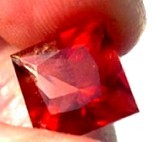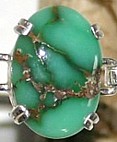
Treatment of Tanzanite Gems

 |
Treatment of Tanzanite Gems
|
 |
Tanzanite
is the gem name for the silicate mineral Zoisite. Although
this fairly common mineral has long been known to geologitsts, the gem form of this
mineral was only discovered in 1967. While there are a few other deposits,
virtually all the gem quality material used in the trade is recovered from a single large
geologic zone about 5 miles long, located in the Merilani Hills of Tanzania, Africa. That
of course, is how the gem acquired the name of tanzanite. Few people know that the gem
tanzanite actually comes in a variety of colors, including yellows, greens and of course
the best known color of blue shading to purplish blue.
This best known coloration resembles the finest Sapphire in many ways, and
is the source of its great popularity. Some
of the green shades of this gem are actually colored by the presence of the element
chromium and resemble a very fine emerald. Stones
of this emerald green hue are extremely rare, and the color is not achieved through any
form of treatment. Few
people also know that the color of the well-known beautiful blue violet of Tanzanite is
not a natural color for most of the material that is mined.
The vast majority of all tanzanite as it is mined comes out of the ground
displaying a brownish color. This material actually shows a strong violet red / deep blue
/ yellow green trichroic coloration, meaning that different colors are displayed when the
stone is viewed in different directions. The mixed combination of these different colors
appear under normal viewing as a brownish to brownish violet kind of coloration. Some of the best natural stones actually have a
coloration similar to that of root beer before treatment.
A gentle heating for about two hours at a temperature of 370°C will convert
the brownish natural material to the desired violet blue coloration. Application of this heat for too long a time period will change
fine colored stones to a light blue color, that is less desirable. In heating
Tanzanite, it is best to raise and lower the temperature of the material very slowly as
the gem is somewhat fragile toward heat, and rapid changes may cause fractures. It is common practice to cut and polish the rough
stones in their untreated form, and remove all the flaws and imperfections as a part of
the cutting process. That way only the
cleanest, most imperfection free parts of the stone are the ones that are then
treated to produce those beautiful sapphire blue color gems. This helps to reduce the potential for any
unintended cracking or other damage which may occur during heating process. Temperatures
more than about 400° centigrade are usually unnecessary, and on heating to temperatures
over 900° centigrade will remove water from the crystal, cause it to become cloudy and
destroy the stone. |
|
| For
whatever reason, this heat treatment of tanzanite is almost never disclosed to buyers. The
normal blue to blue-violet coloration is fully stable and does not change during normal
jewelry wear and usage. A very small portion
of the tanzanite crystals which are mined actually have a natural blue violet color, but
distinguishing these naturally colored stones from those which have been heat-treated to
achieve the desired color is impossible and no testing for the normal heat treatment is
ever made. |
|
|
Want to know a little bit more about this crazy prospector guy? Well, here's a little bit more about me, and how I got into prospecting: Chris' Prospecting Story